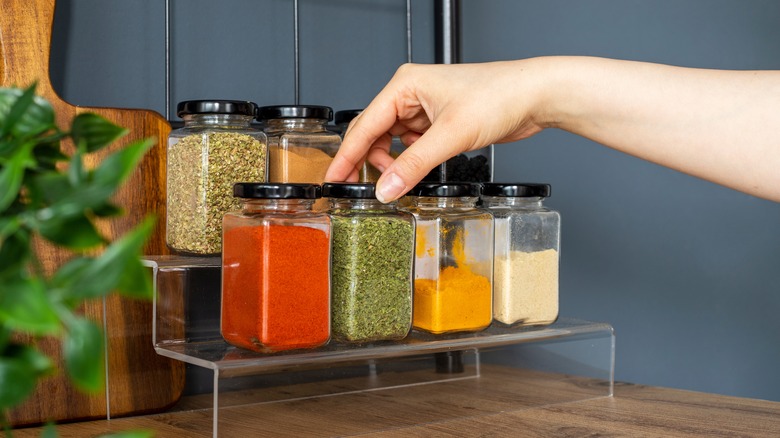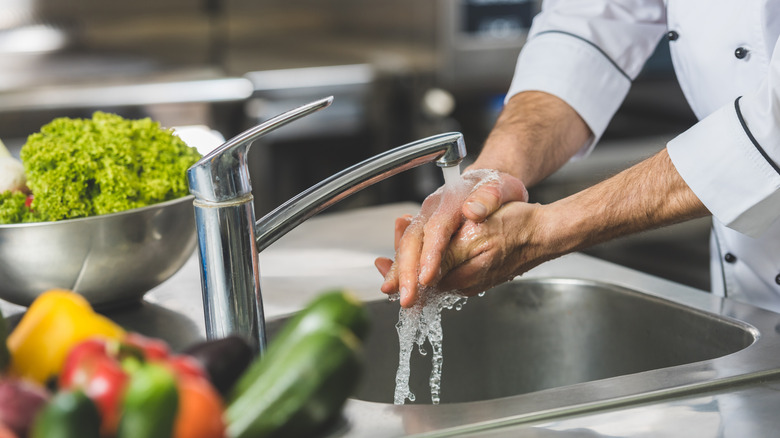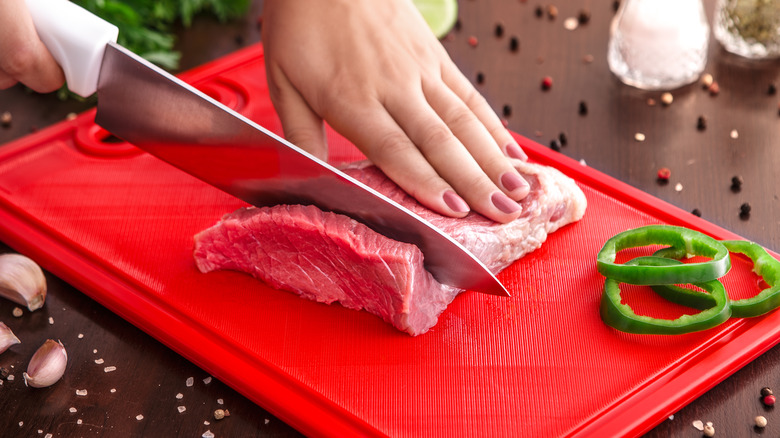Why You Need To Clean Your Spice Jars ASAP
Whether you like to decant pantry staples like spices into new containers, or you've left them in their original packaging, you should seriously consider giving all your herb and spice containers a good cleaning. The surface of greatest concern isn't on the inside, in direct contact with your spices and seasonings, but the outside.
According to a 2022 study published by the Journal of Food Protection, up to 48% of spice jars sampled in a test showed traces of MS2 contamination. MS2 is a bacteriophage, meaning it infects bacteria like E. coli with viruses, but MS2 itself is harmless to humans. As such, scientists commonly use it to mimic pathogens in research projects like this one. MS2's presence demonstrates that most of the spice jars in our kitchens are very likely contaminated with more dangerous bacteria.
As you might expect, such contamination happens when we handle spice jars while preparing of raw meat. Even if you forget to wash your hands just once after cutting some chicken, then you go ahead and season it, your spice jars and shakers can wind up with trace amounts of salmonella or E. coli on the outside, with the potential to spread the contamination to anything else they touch –- including your hands, the next time you use that spice jar.
How to avoid contaminating spice jars
Avoiding cross-contamination in the kitchen can be easier said than done. That being said, you can reduce the health risks by avoiding common meal prep mistakes. Wash your hands frequently, and immediately after dealing with any raw meat or even other raw foods, from eggs to veggies. This alone can prevent you from contaminating a spice jar with dangerous meat juices.
You should also be sure to keep your utensils and work spaces clean. Even if your hands are clean, bacteria could have transferred from raw meat to the counter, your cutting board, and any other surfaces you use. Any spice jar then set on that counter can be potentially contaminated. To keep everyone safe, you can effectively disinfect surfaces (both counters and the exterior of spice jars) with ethyl alcohol, methyl alcohol, or hydrogen peroxide, according to the CDC. All three can effectively denature pathogens.
Another good habit to get into is regularly cleaning out your spice cabinet. Not only can you give each jar a quick wipe-down, but you can also examine each container to make sure none of your herbs or spices have expired and none of the jars have cracked.
How do other kitchen tools compare?
Given the scary statistics associated with spice jar contamination, you might be wondering how the other surfaces in your kitchen compare. Fortunately, spice jars are by far the most concerning, with an average contamination rate of 48%. The tool with the next highest rate is cutting boards at 12.7%. Trash can lids followed closely behind. Both of these make sense, given their frequent contact with raw and unwashed foods.
On the other end of the spectrum, refrigerator handles and inner sink spaces tallied at less than 10% each -– statistically low enough to be disqualified from further testing. You still shouldn't be licking your fridge handle, but at least it's safer than a spice jar.
In general, containers of cleaning supplies and the areas where we store them have lower contamination rates, while cooking and eating utensils and their storage places have higher rates. Of course, regardless of the contamination risk rate associated with a particular item, it's important to stay safe and keep everything in the kitchen as clean as possible. Oh, and maybe wash that wooden cutting board again.



